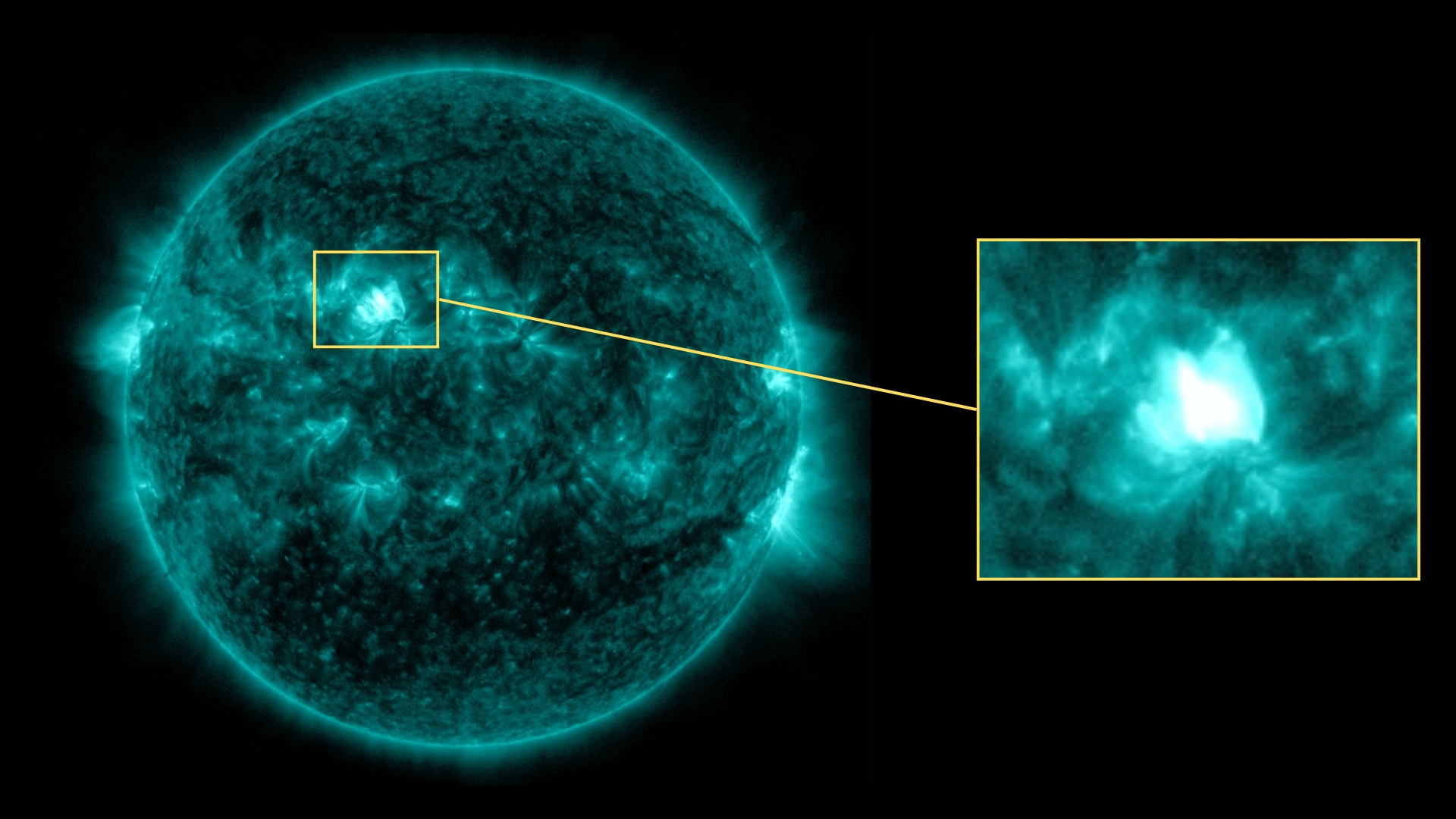How to Track Elon Musk's Tesla Roadster Using Mobile Apps
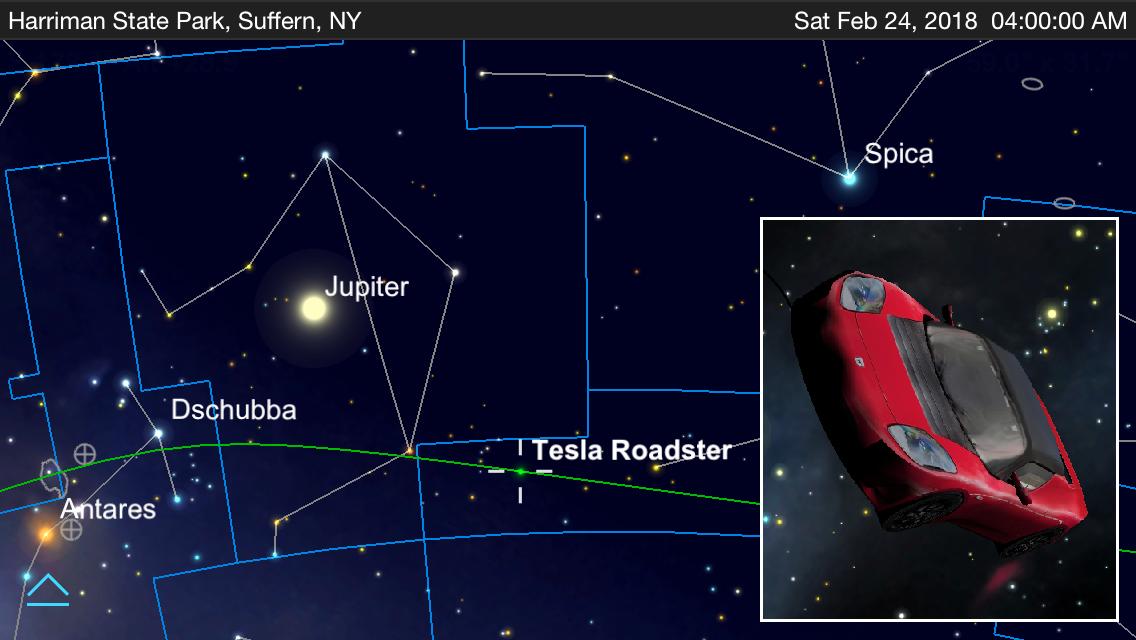
Since its launch atop the SpaceX Falcon Heavy rocket on Feb. 6, Elon Musk's cherry-red Tesla Roadster has become the solar system's newest "minor body." Although the car, with its spacesuited mannequin named Starman at the wheel, is too small and too far from Earth to be seen by amateurs, professionals continue to capture images of its tiny point of light moving across the distant stars.
The Roadster's current orbit will carry it out beyond Mars into the inner edge of the main asteroid belt and will return it to Earth's orbit every 19 months — possibly for millions of years to come. In this edition of Mobile Stargazing, we'll tell you how to use mobile apps to understand the Roadster's orbit, follow its journey through interplanetary space and find out when it might return within reach of Earth-bound telescopes. [Watch Starman's Entire Deep-Space Ride in 80 Seconds]
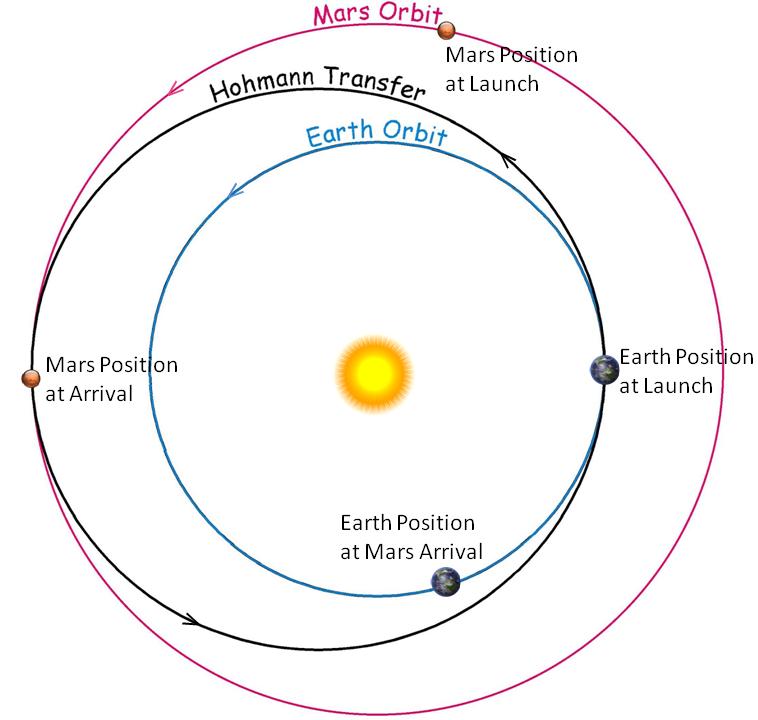
The journey to Mars
SpaceX used the Tesla Roadster's launch to demonstrate that payloads on the Falcon Heavy rocket could escape Earth's gravity well and travel to Mars and beyond. The Roadster was launched into a Hohmann transfer orbit. This is an elliptical orbit designed to use the least amount of fuel to shuttle a spacecraft between two bodies orbiting the same center of mass in the same plane — in this case, Earth and Mars.
To reach a Hohmann orbit, the spacecraft needs to launch at a particular time and with a specified velocity. After a final burn to leave Earth orbit, the spacecraft coasts during the transfer and arrives at the destination when the target body is also there. Because a Mars orbit or landing wasn't in the plan, SpaceX's launch window was flexible. (The alignment to get from Earth to Mars with that orbit and the shortest trip time occurs only every 26 months; SpaceX's goal was just to show that it could get far enough to reach Mars, if it had launched at the right time.)
Related: Track Tesla in Space
If a spacecraft in a Hohmann orbit doesn't land on — or enter orbit around — the destination body, its orbit will continue around the sun, eventually returning to Earth's vicinity, and then to Mars again, and so on. Some planetary exploration concepts use this shuttling idea to transfer supplies between planets — slowly, but cheaply.
The images of the red Roadster floating in front of Earth were spectacular. After the onboard cameras ceased to send pictures, the car was still close enough to Earth, and bright enough, to be imaged using ground-based cameras mounted on tracking telescopes. Many images published were composed of individual frames spaced apart in time to show the car passing in front of the distant stars. Some imagers were even able to discern brightness variations that indicated the car was slowly tumbling. [How We Know This Tiny Pinprick of Light Is the Tesla Roadster]
Get the Space.com Newsletter
Breaking space news, the latest updates on rocket launches, skywatching events and more!
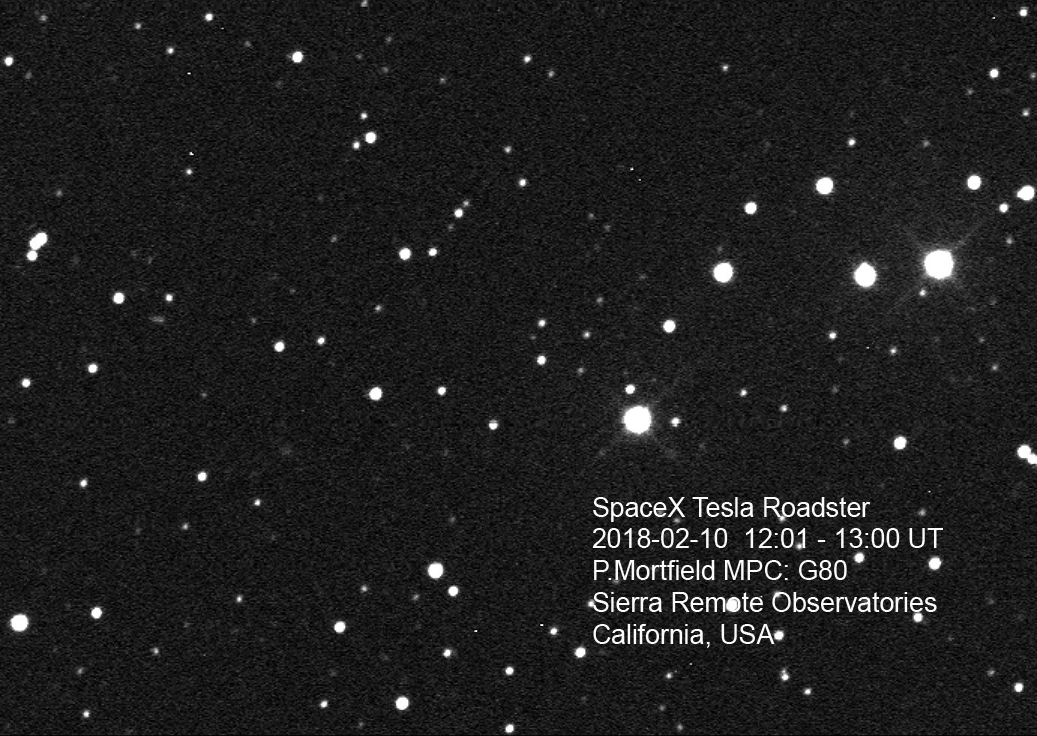
Prepping your app for tracking the Roadster
The Tesla Roadster is now orbiting the sun, not Earth, so it is technically considered a minor body or solar system object (or even an interplanetary spacecraft), and not a satellite. However, because it's an artificial object, some apps, including Star Walk 2, list it under Satellites. In SkySafari 6 for iOS, you can find it by typing "Tesla" into the search bar. The resulting list should include the Roadster, the asteroid (2244) Tesla and some features on the moon. If you don't see the Roadster listed, the app's minor-body catalog needs an update. SkySafari 6 and Star Walk 2 were the only sky-charting apps I found that included the Roadster, but other apps may add it in the future.
Many astronomy apps automatically download object updates from time to time in the background or handle it through the regular app software updates. Because the Roadster is a brand-new object, it may not be present if your app's solar system object catalog is not up-to-date.
In SkySafari 6, you can manually update the minor-body database. To do this, your device will need to be able to receive external data via a local Wi-Fi connection or your service provider's data plan. (After that, though, the app can operate without a connection.)
Under the Settings menu, select Solar System, and scroll to the bottom of the page, where you will see a colored link labeled "Update Minor Body Data." Below this are the date and time of the last update. When you tap the link, the label will dim and change to "Updating Minor Body Data …" This can take a few minutes. You can exit the Settings menu and use the app while it downloads the update. When the update is complete, the app will alert you via a pop-up. My SkySafari 6 Pro minor-body update required 100 megabytes. The smaller object catalog in the Plus version will download less data.
A fun extra that was recently added to SkySafari 6 is a 3D rendering of the red Tesla Roadster in space (minus the Starman driver and the Falcon Heavy upper stage which is still attached to the car). Visit the Apple store to update it if your app is not version 6.0.4.30 or later. This icon is not yet available to Android users. And as of this writing, the latest Android version of SkySafari 5 Plus, version 5.4.0.0, did not include an accurate orbit for the Roadster. But this should be remedied soon.
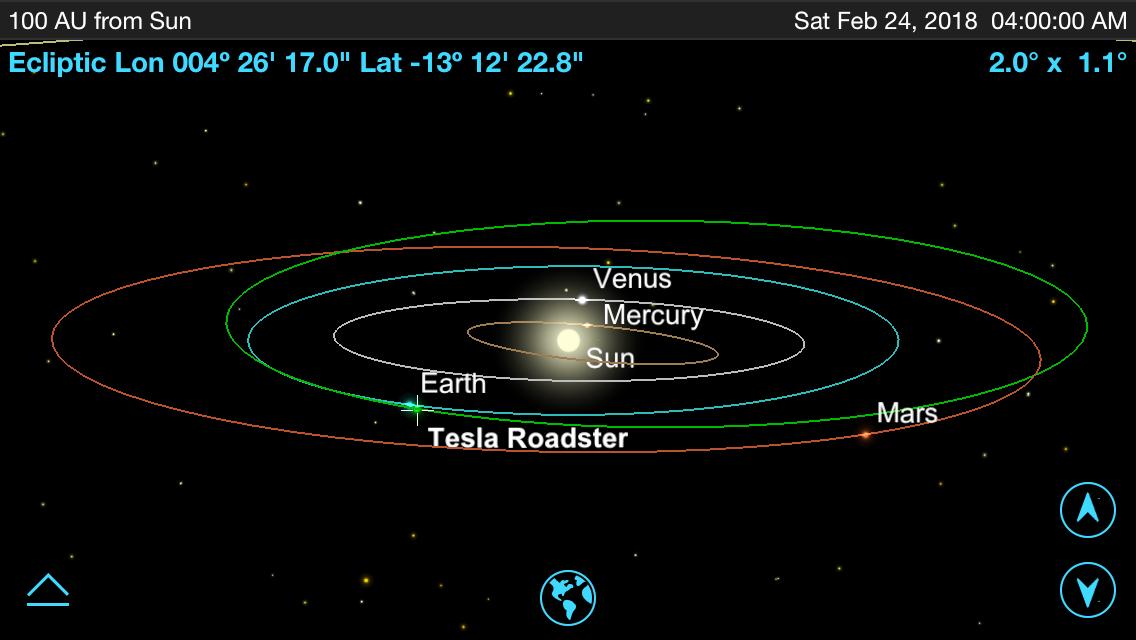
Displaying the Roadster's orbit
To get an idea of where the Tesla Roadster is going to spend the next few million years, you can use the SkySafari 6 app to display its orbit around the sun. Here's how.
Search for the sun, and tap the Orbit icon. (It doesn't need to be daytime.) Pinch or expand the display until the orbits of the inner planets out to Mars are clearly shown. Next, open the Search menu, and type "Tesla." Select the Roadster, and its Object Info page will appear. Now tap Done. The current location of the Roadster and its orbit around the sun will appear, highlighted in green. If you don't see the Tesla's orbit, ensure that the app's Show Selected Object Orbit setting has been enabled.
You can find the details about the Roadster's orbit on its Info page. The Roadster is orbiting the sun once every 571 days. The orbit's closest distance from the sun (shown in the app as the periapse value) is 0.986 astronomical unit. (One AU is the average Earth-sun distance — roughly 93 million miles, or 150 million kilometers). The orbit's closest distance from the sun, therefore, equals 91.66 million miles (147.5 million km) — close to the Earth's perihelion distance, or the closest Earth gets to the sun. The car will cross Earth's orbit every 19 months or so, but we won't always be there to meet it. More on that later.
At the Roadster's farthest distance from the sun, known as its aphelion, the car will reach about 1.71 AU, or about 11 percent farther than Mars' mean orbital radius of 1.530 AU. At this distance, the car might encounter some main-belt asteroids. The asteroid designated 7 Iris has a similar perihelion but a much more elongated orbit than the planets have. Companies that are interested mining asteroids want to be able to deliver payloads that far from the sun.
The Roadster's orbital inclination has a very small value of 1.1282, meaning it orbits nearly in the plane of our solar system. You can demonstrate this in SkySafari 6 by using one finger to rotate the 3D-rendered solar system.
Will the Tesla Roadster return?
Once you have the app set up to show the Roadster's orbit, you can open the Time control and run time forward or backward, continuously or stepping through in selected time increments, to see where the Roadster will go from here.
To find out when the Roadster will next pass close to Mars or Earth, advance the date in the app month by month until planet and car symbols converge. The Roadster will cross Mars' orbit in early July 2018 and again in mid-April 2019, but the Red Planet will not be nearby. The Tesla will next cross Earth's orbit in early September 2019, but Earth will be on the opposite side of the sun.
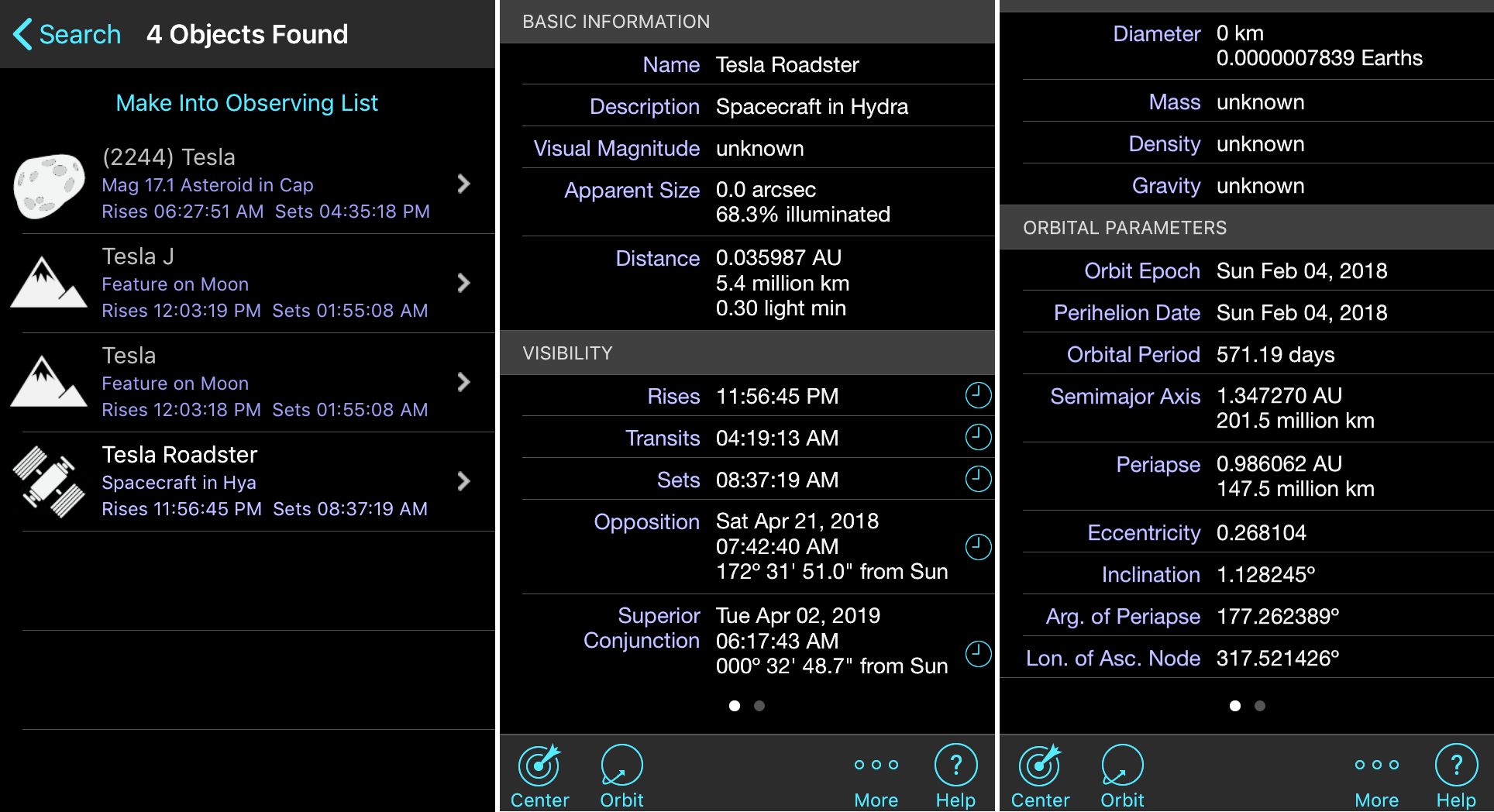
The opportunities for the Roadster to pass near enough to Earth to be captured by our planet's gravity are slim indeed. In fact, the next closest approach of the car and Earth will occur somewhere around New Year's Day of the year 208,417! (I used the least-common multiple of the two objects' orbital periods to calculate that timing.) You can plug that date into SkySafari 6 and see the encounter for yourself. (To enter such a large year, open the Date and Time settings, and tap Advanced. Then, manually enter date, and tap Done.) Zooming the display will show that the Roadster won't come closer than the moon's distance from Earth.
All of the information above is based on the current orbit. Over time, this may change due to solar heating and gravitational tugs by other solar system objects. Scientists recently calculated that the chances of the Roadster colliding with Earth within the next million years are about 6 percent, and 2.5 percent for colliding with Venus. If the Roadster does ever fall to Earth, though, it will harmlessly burn up during re-entry.
Where is the Tesla Roadster in the sky?
When you are finished seeing the Tesla Roadster's orbit, tap the Orbit icon to return the view to the sky from your location on Earth. In this mode, you can see where in the sky the Roadster is positioned at any given time. On Feb. 24, 2018, the car is sitting off the tail end of the constellation Hydra, near the deep-sky object NGC 5694. This is about 14 degrees southwest (to the right) of Jupiter in the southeastern predawn sky.
For the next several months, the Roadster will move by several arc minutes of sky per day. After the first week of March, it will rise before midnight and then earlier each night. By May 1, it will be sitting 26 degrees above the southeastern horizon at 10 p.m. local time — about a palm's width below the bright star Spica. You will not be able to see the red Roadster, but it will be fun to imagine it. Barring any interference, Starman will continue to shuttle alone in interplanetary space between the orbits of Earth and Mars for millions of years. But that's OK — he's got "Ziggy Stardust" on the radio! [Astrophotographer Spots Elon Musk's Roadster Cruising Through Space (Video)]
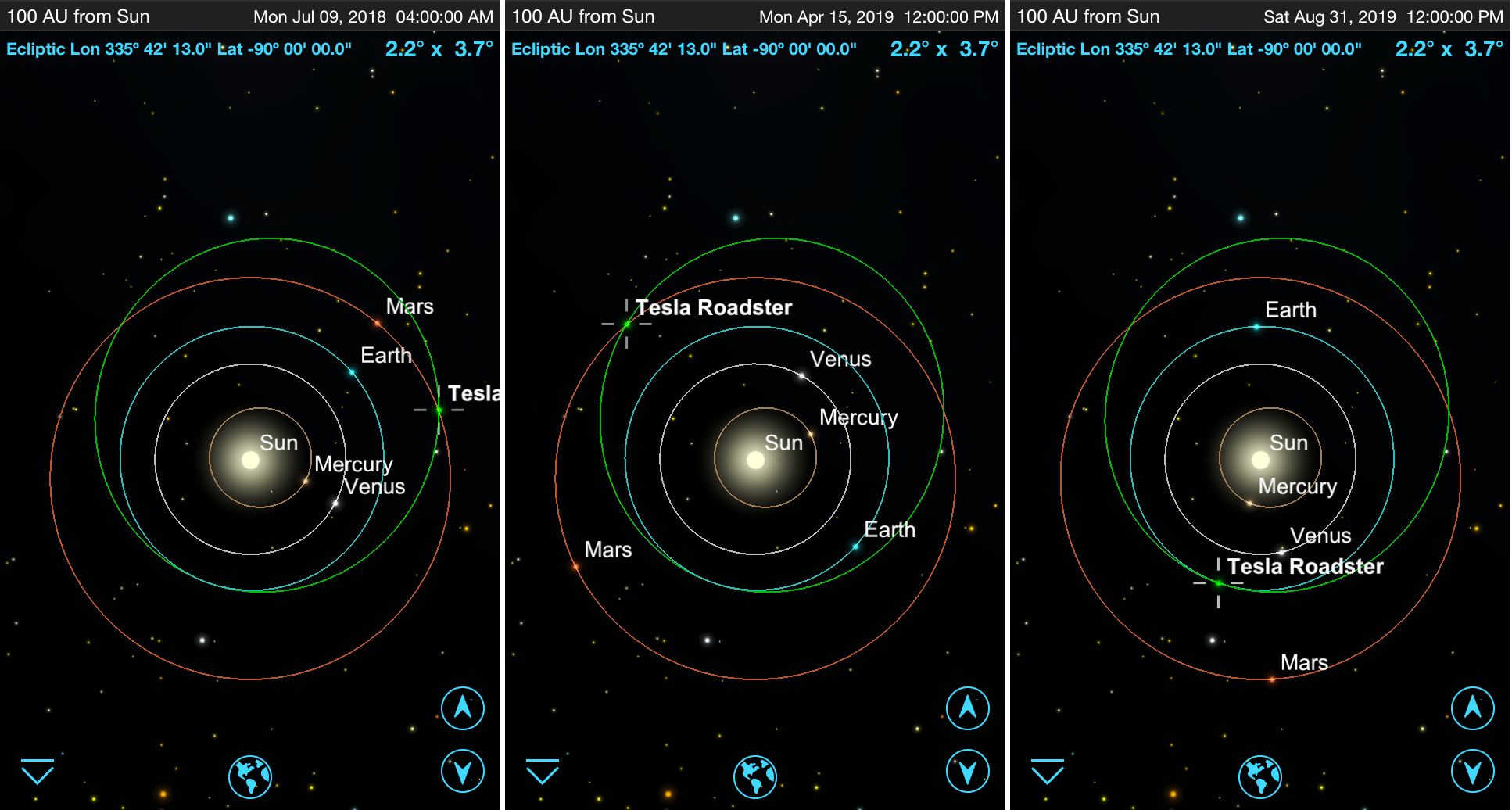
Going beyond — another way to track the Roadster
A new website created by Ben Pearson, called Whereisroadster.com, lets you track the car from your computer or phone browser. It contains a simple animation showing the Roadster's position in the solar system, lists some upcoming encounter dates, answers some frequently asked questions and even gives you the estimated "miles per gallon" of the vehicle and the number of times Starman has heard "Space Oddity" (assuming the battery still works). It's all good fun.
In future editions of Mobile Astronomy, we'll look at spring galaxies, how the distances to stars are measured and more. In the meantime, keep looking up!
Editor's note: Chris Vaughan is an astronomy public outreach and education specialist at AstroGeo, a member of the Royal Astronomical Society of Canada and an operator of the historic 74-inch (1.88-meter) David Dunlap Observatory telescope. You can reach him via email, and follow him on Twitter @astrogeoguy, as well as on Facebook and Tumblr.
This article was provided by Simulation Curriculum, the leader in space science curriculum solutions and the makers of the SkySafari app for Android and iOS. Follow SkySafari on Twitter @SkySafariAstro. Follow us @Spacedotcom, Facebook and Google+. Original article on Space.com.
Join our Space Forums to keep talking space on the latest missions, night sky and more! And if you have a news tip, correction or comment, let us know at: community@space.com.
Chris Vaughan, aka @astrogeoguy, is an award-winning astronomer and Earth scientist with Astrogeo.ca, based near Toronto, Canada. He is a member of the Royal Astronomical Society of Canada and hosts their Insider's Guide to the Galaxy webcasts on YouTube. An avid visual astronomer, Chris operates the historic 74˝ telescope at the David Dunlap Observatory. He frequently organizes local star parties and solar astronomy sessions, and regularly delivers presentations about astronomy and Earth and planetary science, to students and the public in his Digital Starlab portable planetarium. His weekly Astronomy Skylights blog at www.AstroGeo.ca is enjoyed by readers worldwide. He is a regular contributor to SkyNews magazine, writes the monthly Night Sky Calendar for Space.com in cooperation with Simulation Curriculum, the creators of Starry Night and SkySafari, and content for several popular astronomy apps. His book "110 Things to See with a Telescope", was released in 2021.


